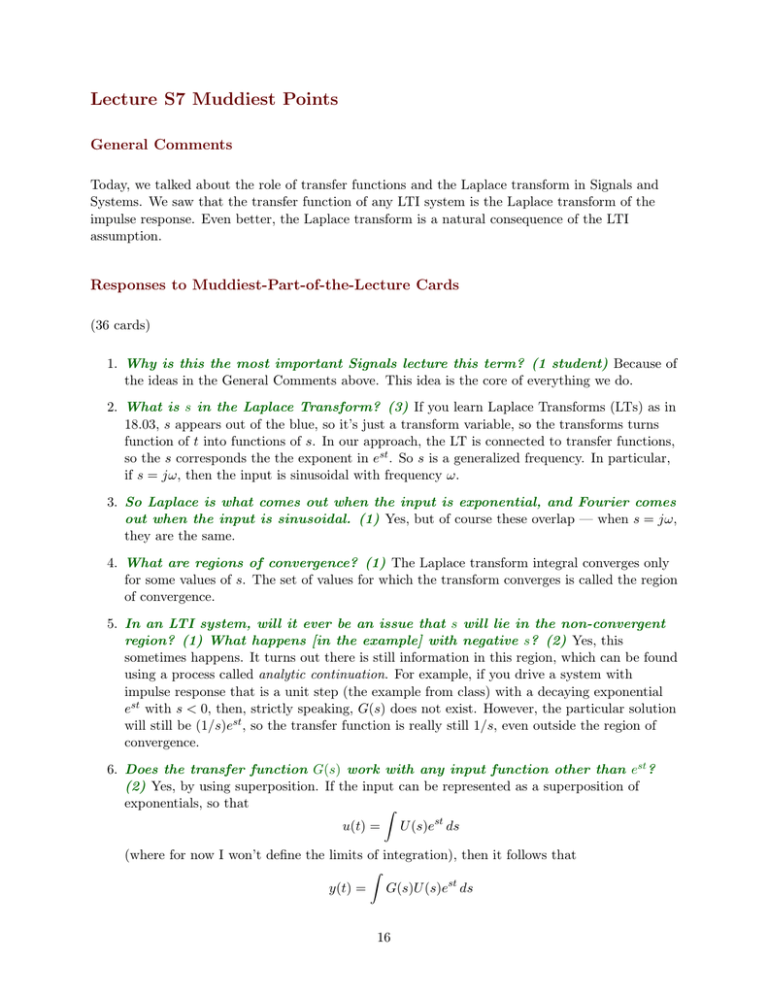Lecture S7 Muddiest Points General Comments
advertisement

Lecture S7 Muddiest Points General Comments Today, we talked about the role of transfer functions and the Laplace transform in Signals and Systems. We saw that the transfer function of any LTI system is the Laplace transform of the impulse response. Even better, the Laplace transform is a natural consequence of the LTI assumption. Responses to Muddiest­Part­of­the­Lecture Cards (36 cards) 1. Why is this the most important Signals lecture this term? (1 student) Because of the ideas in the General Comments above. This idea is the core of everything we do. 2. What is s in the Laplace Transform? (3) If you learn Laplace Transforms (LTs) as in 18.03, s appears out of the blue, so it’s just a transform variable, so the transforms turns function of t into functions of s. In our approach, the LT is connected to transfer functions, so the s corresponds the the exponent in est . So s is a generalized frequency. In particular, if s = jω, then the input is sinusoidal with frequency ω. 3. So Laplace is what comes out when the input is exponential, and Fourier comes out when the input is sinusoidal. (1) Yes, but of course these overlap — when s = jω, they are the same. 4. What are regions of convergence? (1) The Laplace transform integral converges only for some values of s. The set of values for which the transform converges is called the region of convergence. 5. In an LTI system, will it ever be an issue that s will lie in the non­convergent region? (1) What happens [in the example] with negative s? (2) Yes, this sometimes happens. It turns out there is still information in this region, which can be found using a process called analytic continuation. For example, if you drive a system with impulse response that is a unit step (the example from class) with a decaying exponential est with s < 0, then, strictly speaking, G(s) does not exist. However, the particular solution will still be (1/s)est , so the transfer function is really still 1/s, even outside the region of convergence. 6. Does the transfer function G(s) work with any input function other than est ? (2) Yes, by using superposition. If the input can be represented as a superposition of exponentials, so that � u(t) = U (s)est ds (where for now I won’t define the limits of integration), then it follows that � y(t) = G(s)U (s)est ds 16 7. Is there an inverse convolution function that could be used to solve equations containing convolutions? (1) Yes, there is a procedure, which is to take the Laplace transform of the equations, as we did in class! Essentially any workable approach is going to involve Laplace transforms. 8. We are finding G(s). What is it good for? (1) Lots of things! For me, I usually care about the transfer function in order to design control systems — the transfer function is the starting point for most control system design. 9. Don’t know how you got Y = G(s)U in the control loop. Also, what is k? (1) We assumed that the input u(t) is exponential, so that u(t) = U est . We know from experience with LTI systems (and from the later derivation) that an exponential input to an LTI system produces an exponential output. The ratio of the amplitudes is defined to be G(s), the transfer function. We then showed that the transfer function is the LT of the impulse response. k is the control gain from the error signal to the control input. It is chosen by the control system designer to give the best performance for the closed­loop system. 10. Is the general method for solving the convoluted LTI systems to us LTs? (1) Yes, sort of. LTs are the most common tool used for analyzing LTI systems, for the reasons discussed in class, and for other reasons. 11. It seems counter­intuitive that a diverging input u(t) = est would yield a convergent output, while a decaying input does the opposite. (1) Yes, it does. However, the convolution is trying to find y(t) at a finite time t, before the exponential has diverged. However, if the exponential is decaying as time goes forward, then it must be increasing exponentially as time goes backward. So to input a decaying exponential, you have to integrate an exponential that diverges over the region of integration (−∞, t). 12. How do you know that convolutions can be multiplied using transforms? (1) We’ll go over this next time in lecture. It turns out that the LT of g(t) ∗ u(t) is G(s)U (s). 13. How can you physically have a complex input? (1) You can’t, but you can have two complex inputs! For example, u(t) = ejωt = cos ωt + j sin ωt which is complex, and so is unphysical. But u(t) = ejωt + e−jωt = 2 cos ωt is real, and therefore physical. From an analysis point fo view, it’s often better to think of u(t) as ejωt + e−jωt , rather than 2 cos ωt. 14. Is there any way to explain what the LT does? Or is it just math? (1) “Just” math? Heresy! Seriously, it is math, but with a purpose. Among other things, it’s how you find the transfer function of an arbitrary system. 15. Once we find G(s), we can find Y (s), then do we just undo the transform to get y(t)? (1) Yes! 17 16. No mud. (14) Good. Comments: “Can we do more interactive examples in recitation?” Yes, I will do more of these. Why doesn’t this lecture correspond to the online notes? I changed the order around just a little, based on some of your feedback. I’ll try to clean up the web page to clear this up. I also need to catch up the readings in the text. 18



